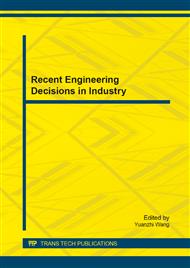[1]
C.M. Uang: Establishing R (or Rw) and Cd Factors for Building Seismic Provisions, Journal of Structural Engineering ASCE Volume 117(1), (1991), pp.19-28.
DOI: 10.1061/(asce)0733-9445(1991)117:1(19)
Google Scholar
[2]
C.M. Uang: Structural Overstrength and Limit State Philosophy in Seismic Design Provisions. Report No CE-91-03 Department of Civil Engineering, Northeastern University (1991).
Google Scholar
[3]
E. Miranda and V. Bertero: Evaluation of Strength Reduction Factors for Earthquake-Resistant Desing, Earthquake Spectra Volume 10(2), 1994, pp.57-379.
DOI: 10.1193/1.1585778
Google Scholar
[4]
N.M. Newmar and W.J. Hall: Earthquake Spectra and Design Monograph Series, Earthquake Engineering Research Institute Berkeley, California (1982).
Google Scholar
[5]
A.H. Hadjia: An Evaluation of the Ductility Reduction Factor Q in the 1976 Regulations for the Federal District of Mexico Earthquake Engineering and Structural Dynamics, Volume 18 (1989), pp.217-231.
DOI: 10.1002/eqe.4290180207
Google Scholar
[6]
D. Arroyo-Espinoza and A. Teran-Gilmore: Strength reduction factors for ductile structures with passive energy dissipating devices, Journal of Earthquake Engineering, Volume 7(2), (2003), p.297–325.
DOI: 10.1080/13632460309350450
Google Scholar
[7]
D. Karmakar and V.K. Gupta: A parametric study of strength reduction factors for elasto-plastic oscillators, Sādhanā, volume 31(4), (2006), pp.343-357.
DOI: 10.1007/bf02716781
Google Scholar
[8]
A. Ayouba and M. Chenouda: Response spectra of degrading structural systems, Engineering Structures, Volume 31, (2009), pp.1393-1402.
DOI: 10.1016/j.engstruct.2009.02.006
Google Scholar
[9]
L. Sanchez-Ricart and A. Plumier: Parametric study of ductile moment-resisting steel frames: A first step towards Eurocode 8 calibration, Earthquake Engineering & Structural Dynamics, Volume 37(7), (2008), pp.1135-1155.
DOI: 10.1002/eqe.809
Google Scholar
[10]
A. Reyes-Salazar and A. Haldar: Seismic Response and Energy Dissipation in Partially Restrained and Fully Restrained Steel Frames: An Analytical Study, Steel & Composite Structures, An International Journal, Volume 1(4), (2001), pp.459-480.
DOI: 10.12989/scs.2001.1.4.459
Google Scholar
[11]
A. Reyes-Salazar: Ductility and Ductility Reduction Factors, Structural Engineering and Mechanics An International Journal, Volume13(4), (2002), pp.369-385.
DOI: 10.12989/sem.2002.13.4.369
Google Scholar
[12]
A. Nassar A and H. Krawinkler: Seismic Demands of SDOF and MDOF Systems, John A. Blume Earthquake Engineering Center, Report No. 95, Stanford University (1991).
Google Scholar
[13]
J. Cai, J. Zhou and X. Fang: Seismic Ductility Reduction Factors for Multi-Degree-of-Freedom Systems, Advances in Structural Engineering Volume 9(5), (2006), pp.591-601.
DOI: 10.1260/136943306778827547
Google Scholar
[14]
A.K. Chopra: Dynamics of Structures, Prentice Hall, New Jersey, (2007).
Google Scholar
[15]
M. Ceylan, M.H. Arsla, R. Ceylan, M.Y. Kaltakci, Y. Ozbay: A new application area of ANN and ANFIS: determination of earthquake load reduction factor of prefabricated industrial buildings, Civil Engineering and Environmental Systems, Volume 27(1), (2010).
DOI: 10.1080/10286600802506726
Google Scholar
[16]
B. Ganjavi and H. Hao: Effect of structural characteristics distribution of strength demand and ductility reduction factor of MDOF systems considering soil-structure interaction, Earthquake Engineering and Engineering Vibration, Volume 11, pp.205-220.
DOI: 10.1007/s11803-012-0111-7
Google Scholar
[17]
L. Gao and A. Haldar: Nonlinear Seismic Analysis of Space Structures with PR connections, International Journal of Microcomputers in Civil Engineering, Volume 10, (1995), pp.27-37.
Google Scholar
[18]
Federal Emergency Management Agency, State of the Art Report on Systems Performance of Steel Moment Frames Subjected to Earthquake Ground Shaking, SAC Steel Project, Report 355C (2000).
Google Scholar


